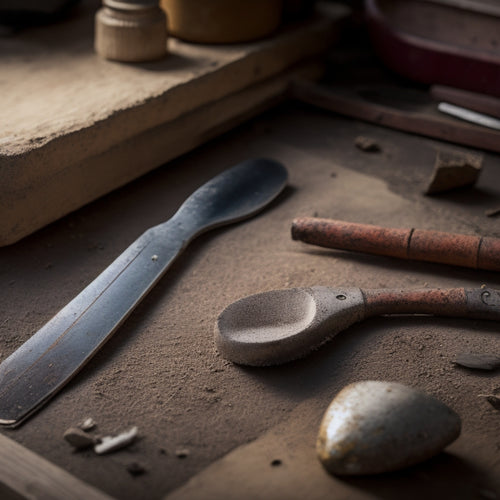
Must-Have Gear for Renovation Protection
Share
When tackling a renovation project, you'll face a multitude of hazards, so it's vital to gear up with the right personal protective equipment (PPE) to prevent injuries and guarantee a safe working environment. You'll need respiratory protection like dust masks, half-face respirators, or full-face respirators, depending on the specific hazards you'll encounter. Eye and face shields, heavy-duty gloves, steel-toed boots, hard hats, and ear protection are also must-haves. Additionally, consider fall protection equipment and skin and body protection to safeguard yourself from head to toe. Now that you know the essentials, you can take the next step to creating a safe renovation workspace.
Key Takeaways
• Respiratory protection is essential, with three main mask types: dust masks, half-face respirators, and full-face respirators, each suited for specific hazards.
• Eye and face protection is critical, with shields featuring proper fit, adjustable headbands, and secure seals to prevent hazardous material exposure.
• Hand protection requires heavy-duty gloves with grip, traction, and puncture resistance, as well as reinforced areas for secure handling of sharp objects.
• Foot protection involves wearing steel-toed boots with proper fit, slip-resistant soles, and quality materials to ensure safety and durability.
• A combination of head, ear, fall, and skin protection gear is necessary to provide comprehensive protection during renovation tasks.
Respiratory Protection Essentials
When working with power tools, sanding, or demolishing, you'll frequently generate airborne contaminants that can cause respiratory distress, making it essential to wear respiratory protection essentials to safeguard your health.
Respiratory hazards are a serious concern in renovation projects, and neglecting to wear proper protection can lead to severe health issues.
To combat these hazards, you'll need to choose the right mask type for your specific task. There are three primary categories: dust masks, half-face respirators, and full-face respirators. Dust masks provide basic protection against particulate matter, while half-face respirators offer a higher level of protection against both particles and gases. Full-face respirators, on the other hand, provide thorough protection against all types of airborne contaminants.
When selecting a mask, consider the specific hazards you'll be facing, the level of protection you need, and the comfort and fit of the mask.
Eye and Face Shields
You'll need to shield your eyes and face from hazardous materials and debris that can cause severe injuries, such as chemical splashes, flying particles, and broken glass, which are common risks in renovation projects.
To guarantee ideal protection, you must choose the right eye and face shields. Look for shields with a proper fit, adjustable headbands, and a secure seal around your eyes and face. This will prevent hazardous materials from seeping in and compromising your safety.
When selecting lens types, consider the specific hazards you'll face during the renovation. For example, polycarbonate lenses offer excellent impact resistance, while acetate lenses provide superior optical clarity.
Anti-fog coatings and scratch-resistant treatments can also enhance your shield's performance. Additionally, consider shields with built-in ventilation systems to reduce fogging and improve airflow.
Heavy-Duty Gloves Selection
When selecting heavy-duty gloves for your renovation project, you'll want to prioritize grip and traction to prevent accidents.
You should look for puncture-resistant palm material that can withstand the rigors of handling sharp objects and rough surfaces.
Grip and Traction Matters
Selecting heavy-duty gloves with ideal grip and traction is essential to prevent accidents and injuries on the renovation site, as slippery surfaces and heavy materials can quickly turn a routine task into a hazardous situation.
You'll want to look for gloves that incorporate advanced grip materials, such as synthetic rubber or silicone, which provide superior traction on wet, oily, or uneven surfaces.
Additionally, consider gloves with specialized traction techniques, like textured palm patterns or grip-enhancing ridges, to guarantee a secure hold on tools and materials.
A good grip can mean the difference between completing a task safely and efficiently, or risking a costly accident.
Don't compromise on grip and traction – it's not worth the risk. Instead, invest in high-quality, heavy-duty gloves that prioritize your safety and performance.
Puncture-Resistant Palm Material
Opting for heavy-duty gloves with puncture-resistant palm material guarantees your hands remain protected from sharp objects and rough surfaces that can easily penetrate thinner materials. This allows you to work with heavy machinery, rough wood, and other hazardous materials without compromising your safety.
When selecting gloves, look for puncture-resistant features such as reinforced palms, fingers, and thumbs. These features will provide an additional layer of protection against sharp edges, nails, and other hazards.
The material durability of the gloves is also essential. Opt for gloves made from high-quality, heavy-duty materials that can withstand the rigors of renovation work. Synthetic materials like polyurethane and polyester are excellent choices, as they offer superior puncture resistance and durability.
Additionally, consider gloves with a textured palm to provide extra grip and traction, ensuring you maintain control even in slippery conditions.
Steel-Toed Boots Requirements
When you're selecting steel-toed boots for your renovation project, you'll want to prioritize three key factors.
You're looking for boots that meet high quality standards, fit comfortably without being too loose or too tight, and feature slip-resistant soles that can grip various surfaces.
Boot Quality Matters
You demand boots that meet the highest standards of quality, durability, and safety to protect your feet from the rigors of renovation work. When it comes to boot quality, you can't afford to compromise. Look for boots that are built with high-quality materials, such as full-grain leather or rugged synthetic materials, and feature robust construction that can withstand the demands of your job site.
The right boot style is also vital. You'll want boots that are designed specifically for renovation work, with features like slip-resistant soles, breathable membranes, and ankle support. Consider boots with a low-cut profile for mobility or insulated boots for cold weather work. Whatever style you choose, make certain they're built to last.
Regular boot maintenance is essential to extend the life of your boots. Clean them regularly, condition the leather, and store them properly when not in use. By investing in high-quality boots and taking care of them, you'll guarantee your feet stay protected and comfortable throughout your renovation project.
Size and Fit
With high-quality boots that meet the demanding standards of renovation work, it's equally important to verify a proper fit. Even the best boots can be hazardous if they're too loose or too tight, which is why it's crucial to understand the specific size and fit requirements for steel-toed boots.
To guarantee a comfortable and safe fit, follow these guidelines:
-
Take proper measurements: Measure both feet, as one foot may be larger than the other. Record the length, width, and arch length to guarantee accurate sizing.
-
Try before you buy: If possible, try on boots before purchasing to verify a comfortable fit. Walk around, bend, and move to simulate renovation work.
-
Make size adjustments: If needed, make adjustments to the lacing, tongue, or insoles to achieve a snug fit. Avoid over-tightening, which can restrict blood flow.
- Check the manufacturer's sizing chart: Refer to the manufacturer's sizing chart to verify you're ordering the correct size. Don't assume your usual shoe size will translate to the same boot size.
Slip-Resistant Soles
Steel-toed boots must feature slip-resistant soles that meet specific requirements to guarantee traction on various surfaces, thereby preventing slips, trips, and falls on renovation sites.
You should look for boots with soles made from high-quality shoe materials that provide ideal grip on different surfaces, including concrete, wood, and metal. The sole technology used should be designed to channel liquids away from the foot, reducing the risk of slipping. Additionally, the soles should have a specific lug pattern that allows for better grip on uneven surfaces.
When selecting steel-toed boots, you should also consider the slip-resistance rating. Look for boots with a rating of at least 0.50, which indicates that they can withstand a minimum of 0.50 g-force on a slippery surface.
Moreover, verify that the boots meet the ASTM F2413-18 standard for slip-resistance, which is the industry benchmark for footwear performance.
Hard Hats and Helmets
Hard hats and helmets are essential personal protective equipment (PPE) for renovation projects, as they shield your head from falling objects, debris, and electrical hazards. You can't afford to compromise on head safety, as even a minor accident can lead to severe head injuries or even fatalities. That's why it's vital to choose a helmet that meets the highest helmet standards.
Here are some key considerations when selecting a hard hat or helmet:
-
Impact resistance: Verify your helmet can withstand impact from falling objects and debris.
-
Electrical resistance: Choose a helmet that provides protection from electrical hazards, such as arc flashes.
-
Comfort and fit: Select a helmet that fits snugly and comfortably, allowing you to focus on the task at hand.
- Certifications: Look for helmets that meet or exceed industry standards, such as ANSI Z89.1 or CSA Z94.1.
Ear Protection Options
Protecting your hearing is vital during renovation projects, as loud power tools and machinery can cause permanent damage to your ears. You're at risk of noise-induced hearing loss, a permanent and irreversible condition, if you don't take the necessary precautions. That's why investing in quality ear protection options is important.
When selecting ear protection, consider the noise reduction rating (NRR) and look for options with a high NRR value. You'll also want to prioritize comfort features, such as soft ear cushions and adjustable headbands, to guarantee you can wear them comfortably for extended periods.
Disposable foam earplugs are a cost-effective option, providing a snug fit and excellent noise reduction. Alternatively, earmuffs with electronic noise cancellation can enhance your listening experience while still protecting your hearing.
Whatever option you choose, make sure it's compatible with your other personal protective equipment (PPE), such as hard hats and safety glasses. By wearing ear protection consistently, you'll safeguard your hearing and maintain peak performance on the job site.
Fall Protection Equipment
When working at heights, you'll need to invest in reliable fall protection equipment to prevent devastating accidents, as a single misstep can result in serious injury or even fatality. As you plan your renovation project, don't skimp on this critical gear. You'll need to choose the right harness type, considering factors like weight capacity, material, and adjustability.
Here are the essentials to include in your fall protection arsenal:
-
Full-body harnesses: these provide maximum support and protection, with straps that distribute force across the body.
-
Lanyards: these connect your harness to an anchor point, absorbing shock in case of a fall.
-
Anchorage points: these secure lanyards, making certain they're attached to a stable structure.
- Rope grabs: these devices move along the rope, locking in place to prevent falls.
Remember to adhere to safety regulations, such as OSHA guidelines, and confirm your equipment meets or exceeds industry standards.
With the right fall protection gear, you'll be empowered to tackle your renovation project with confidence and security.
Skin and Body Protection
As you suit up for your renovation project, don't overlook the importance of skin and body protection, which can shield you from a range of hazards, from cuts and abrasions to toxic chemical exposure.
You'll need gear that can withstand the rigors of demolition, construction, and material handling. Start with gloves that provide grip, dexterity, and puncture resistance. Look for ones with reinforced palms and fingers to prevent skin irritation from rough materials and tools.
Next, consider protective clothing that covers your skin from head to toe. You'll need jackets, pants, and coveralls made from durable, breathable materials that can resist chemical splashes and abrasion.
Don't forget to add a pair of sturdy boots with slip-resistant soles to prevent falls and body fatigue. Finally, a face mask or respirator can protect your respiratory system from airborne contaminants and toxic particles.
By investing in this gear, you'll be able to work with confidence, knowing your skin and body are well-protected from the hazards of renovation work.
Frequently Asked Questions
Can I Reuse Disposable Respirator Filters to Save Money?
When you're considering reusing disposable respirator filters to save money, think twice.
You're compromising filter effectiveness, putting your health at risk. Respirator maintenance is key, and reusing filters defeats the purpose.
Disposable filters are designed for single-use, and reusing them can lead to reduced airflow, increased breathing resistance, and even filter collapse.
Don't gamble with your safety - invest in new filters for peak protection.
How Often Should I Replace My Hard Hat for Optimal Protection?
Imagine your hard hat as a trusty shield, protecting your most valuable asset - your head.
But, just like a shield can become dented and worn, your hard hat has a limited lifespan.
Don't wait until it's too late; replace it every 5 years or sooner if it's damaged.
Look for certification standards like ANSI/ISEA Z89.1, which guarantee your new hard hat meets rigorous safety tests.
Stay protected, stay powerful.
Are There Any Alternatives to Steel-Toed Boots for Smaller Budgets?
You're looking for safety shoe alternatives that won't break the bank.
Fortunately, there are budget-friendly footwear options that still prioritize protection.
Composite-toed boots, for instance, offer similar impact resistance to steel-toed boots at a lower cost.
Aluminum-toed boots are another option, providing a lighter, more affordable alternative without sacrificing safety.
Do I Need to Wear Ear Protection in Quiet Renovation Environments?
Don't be fooled by the whisper-quiet atmosphere of your renovation site – silence can be deceiving.
You're still at risk of permanent hearing damage from prolonged exposure to sounds above 85 decibels. That's why you need to wear ear protection, even in seemingly quiet environments.
The benefits are clear: reduced risk of tinnitus, improved hearing acuity, and a lower likelihood of noise-induced hearing loss.
Can I Use Household Cleaning Products to Clean My Protective Gear?
When cleaning your protective gear, you shouldn't rely on household cleaning products. They can compromise product safety and damage the gear's materials.
Instead, you should opt for gentle, specifically designed cleaning methods that won't affect the gear's performance or integrity.
Always follow the manufacturer's instructions for cleaning and maintenance to guarantee your gear remains effective and safe to use.
Conclusion
As you wrap up your renovation project, remember that safety gear isn't just an accessory, it's a lifeline.
Just like a carpenter's level guarantees a straight line, personal protective equipment keeps you upright and intact.
Consider the story of a contractor who suffered permanent hearing loss from a single, unprotected exposure to a jackhammer.
Don't let that be you.
Invest in the must-have gear outlined above, and you'll be building a safe and healthy future, one renovation at a time.
Related Posts
-

Create a Home Renovation Project Timeline in Excel
You can create a detailed home renovation project timeline in Excel by setting up a tailored template with separate w...
-

Why Renovation Waste Disposal Harms the Environment
When you undertake a renovation project, you're contributing to a staggering problem: renovation waste disposal, whic...
-

Why Inspect Stucco Repair Equipment Before Renovation
When starting a stucco repair renovation, you need to inspect your equipment to prevent accidents, save time and mone...


